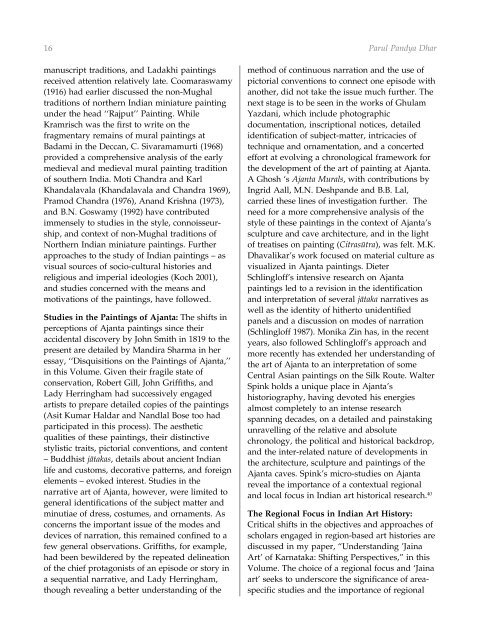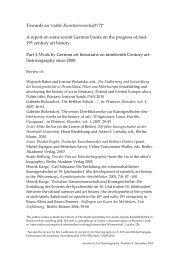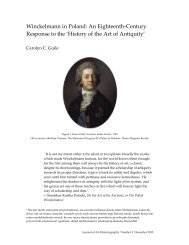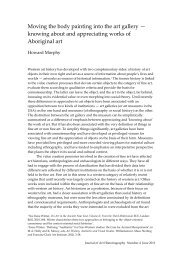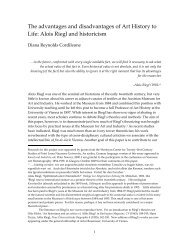Indian Art history.cdr - Journal of Art Historiography
Indian Art history.cdr - Journal of Art Historiography
Indian Art history.cdr - Journal of Art Historiography
Create successful ePaper yourself
Turn your PDF publications into a flip-book with our unique Google optimized e-Paper software.
16<br />
manuscript traditions, and Ladakhi paintings<br />
received attention relatively late. Coomaraswamy<br />
(1916) had earlier discussed the non-Mughal<br />
traditions <strong>of</strong> northern <strong>Indian</strong> miniature painting<br />
under the head ‘‘Rajput’’ Painting. While<br />
Kramrisch was the first to write on the<br />
fragmentary remains <strong>of</strong> mural paintings at<br />
Badami in the Deccan, C. Sivaramamurti (1968)<br />
provided a comprehensive analysis <strong>of</strong> the early<br />
medieval and medieval mural painting tradition<br />
<strong>of</strong> southern India. Moti Chandra and Karl<br />
Khandalavala (Khandalavala and Chandra 1969),<br />
Pramod Chandra (1976), Anand Krishna (1973),<br />
and B.N. Goswamy (1992) have contributed<br />
immensely to studies in the style, connoisseurship,<br />
and context <strong>of</strong> non-Mughal traditions <strong>of</strong><br />
Northern <strong>Indian</strong> miniature paintings. Further<br />
approaches to the study <strong>of</strong> <strong>Indian</strong> paintings – as<br />
visual sources <strong>of</strong> socio-cultural histories and<br />
religious and imperial ideologies (Koch 2001),<br />
and studies concerned with the means and<br />
motivations <strong>of</strong> the paintings, have followed.<br />
Studies in the Paintings <strong>of</strong> Ajanta: The shifts in<br />
perceptions <strong>of</strong> Ajanta paintings since their<br />
accidental discovery by John Smith in 1819 to the<br />
present are detailed by Mandira Sharma in her<br />
essay, ‘‘Disquisitions on the Paintings <strong>of</strong> Ajanta,’’<br />
in this Volume. Given their fragile state <strong>of</strong><br />
conservation, Robert Gill, John Griffiths, and<br />
Lady Herringham had successively engaged<br />
artists to prepare detailed copies <strong>of</strong> the paintings<br />
(Asit Kumar Haldar and Nandlal Bose too had<br />
participated in this process). The aesthetic<br />
qualities <strong>of</strong> these paintings, their distinctive<br />
stylistic traits, pictorial conventions, and content<br />
– Buddhist jätakas, details about ancient <strong>Indian</strong><br />
life and customs, decorative patterns, and foreign<br />
elements – evoked interest. Studies in the<br />
narrative art <strong>of</strong> Ajanta, however, were limited to<br />
general identifications <strong>of</strong> the subject matter and<br />
minutiae <strong>of</strong> dress, costumes, and ornaments. As<br />
concerns the important issue <strong>of</strong> the modes and<br />
devices <strong>of</strong> narration, this remained confined to a<br />
few general observations. Griffiths, for example,<br />
had been bewildered by the repeated delineation<br />
<strong>of</strong> the chief protagonists <strong>of</strong> an episode or story in<br />
a sequential narrative, and Lady Herringham,<br />
though revealing a better understanding <strong>of</strong> the<br />
Parul Pandya Dhar<br />
method <strong>of</strong> continuous narration and the use <strong>of</strong><br />
pictorial conventions to connect one episode with<br />
another, did not take the issue much further. The<br />
next stage is to be seen in the works <strong>of</strong> Ghulam<br />
Yazdani, which include photographic<br />
documentation, inscriptional notices, detailed<br />
identification <strong>of</strong> subject-matter, intricacies <strong>of</strong><br />
technique and ornamentation, and a concerted<br />
effort at evolving a chronological framework for<br />
the development <strong>of</strong> the art <strong>of</strong> painting at Ajanta.<br />
A Ghosh ‘s Ajanta Murals, with contributions by<br />
Ingrid Aall, M.N. Deshpande and B.B. Lal,<br />
carried these lines <strong>of</strong> investigation further. The<br />
need for a more comprehensive analysis <strong>of</strong> the<br />
style <strong>of</strong> these paintings in the context <strong>of</strong> Ajanta’s<br />
sculpture and cave architecture, and in the light<br />
<strong>of</strong> treatises on painting (Citrasütra), was felt. M.K.<br />
Dhavalikar’s work focused on material culture as<br />
visualized in Ajanta paintings. Dieter<br />
Schlingl<strong>of</strong>f’s intensive research on Ajanta<br />
paintings led to a revision in the identification<br />
and interpretation <strong>of</strong> several jätaka narratives as<br />
well as the identity <strong>of</strong> hitherto unidentified<br />
panels and a discussion on modes <strong>of</strong> narration<br />
(Schlingl<strong>of</strong>f 1987). Monika Zin has, in the recent<br />
years, also followed Schlingl<strong>of</strong>f’s approach and<br />
more recently has extended her understanding <strong>of</strong><br />
the art <strong>of</strong> Ajanta to an interpretation <strong>of</strong> some<br />
Central Asian paintings on the Silk Route. Walter<br />
Spink holds a unique place in Ajanta’s<br />
historiography, having devoted his energies<br />
almost completely to an intense research<br />
spanning decades, on a detailed and painstaking<br />
unravelling <strong>of</strong> the relative and absolute<br />
chronology, the political and historical backdrop,<br />
and the inter-related nature <strong>of</strong> developments in<br />
the architecture, sculpture and paintings <strong>of</strong> the<br />
Ajanta caves. Spink’s micro-studies on Ajanta<br />
reveal the importance <strong>of</strong> a contextual regional<br />
and local focus in <strong>Indian</strong> art historical research. 40<br />
The Regional Focus in <strong>Indian</strong> <strong>Art</strong> History:<br />
Critical shifts in the objectives and approaches <strong>of</strong><br />
scholars engaged in region-based art histories are<br />
discussed in my paper, “Understanding ’Jaina<br />
<strong>Art</strong>’ <strong>of</strong> Karnataka: Shifting Perspectives,” in this<br />
Volume. The choice <strong>of</strong> a regional focus and ‘Jaina<br />
art’ seeks to underscore the significance <strong>of</strong> areaspecific<br />
studies and the importance <strong>of</strong> regional


